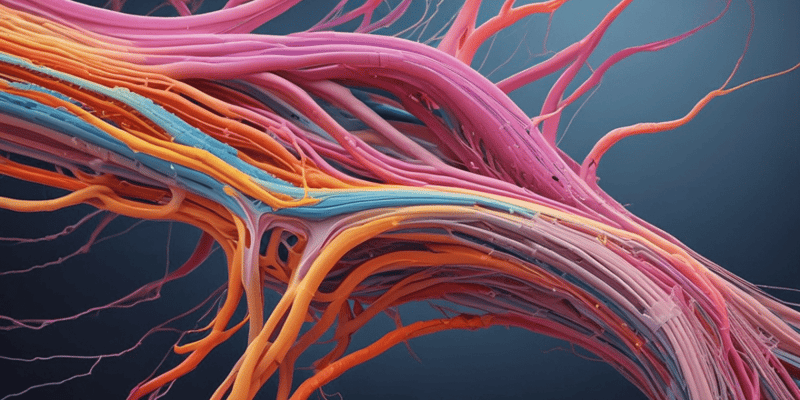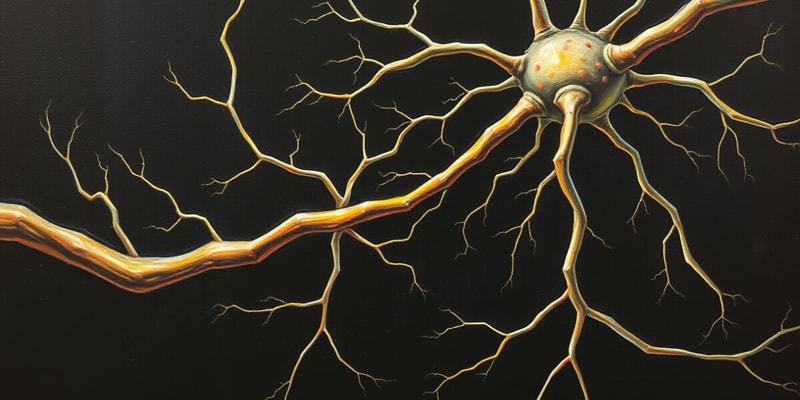Podcast
Questions and Answers
What is the function of the ATP binding sites in the myosin II heads?
What is the function of the ATP binding sites in the myosin II heads?
What triggers the release of acetylcholine from the presynaptic cleft?
What triggers the release of acetylcholine from the presynaptic cleft?
What is the function of the T-tubules in muscle fibers?
What is the function of the T-tubules in muscle fibers?
What is the result of tropomyosin moving on the actin filaments?
What is the result of tropomyosin moving on the actin filaments?
Signup and view all the answers
What is the characteristic of muscle tissue that allows it to respond to stimuli?
What is the characteristic of muscle tissue that allows it to respond to stimuli?
Signup and view all the answers
What is the function of troponin in muscle contraction?
What is the function of troponin in muscle contraction?
Signup and view all the answers
What is the result of the binding of myosin heads to active sites on actin filaments?
What is the result of the binding of myosin heads to active sites on actin filaments?
Signup and view all the answers
What is one of the functions of skeletal muscle in the body?
What is one of the functions of skeletal muscle in the body?
Signup and view all the answers
What is the function of the triad component in skeletal muscle?
What is the function of the triad component in skeletal muscle?
Signup and view all the answers
Which type of muscle has rudimentary sarcoplasmic reticulum and no T-tubules?
Which type of muscle has rudimentary sarcoplasmic reticulum and no T-tubules?
Signup and view all the answers
What is the function of Purkinje fibers?
What is the function of Purkinje fibers?
Signup and view all the answers
What is found in the center portion of Purkinje fibers?
What is found in the center portion of Purkinje fibers?
Signup and view all the answers
What is unique about the nucleus of Purkinje fibers?
What is unique about the nucleus of Purkinje fibers?
Signup and view all the answers
What type of fibers are involved in the contraction of thick filaments?
What type of fibers are involved in the contraction of thick filaments?
Signup and view all the answers
Aside from cardiac muscle, what is also known as visceral muscle?
Aside from cardiac muscle, what is also known as visceral muscle?
Signup and view all the answers
What is composed of desmin and vimentin?
What is composed of desmin and vimentin?
Signup and view all the answers
What happens to the RER when an axon is injured?
What happens to the RER when an axon is injured?
Signup and view all the answers
What happens to the nerve fiber distal to the injury?
What happens to the nerve fiber distal to the injury?
Signup and view all the answers
What happens to the muscle fibers after injury?
What happens to the muscle fibers after injury?
Signup and view all the answers
What happens to the Schwann cells after injury?
What happens to the Schwann cells after injury?
Signup and view all the answers
What is the result of successful nerve regeneration?
What is the result of successful nerve regeneration?
Signup and view all the answers
What undergoes conformational changes after binding with Calcium?
What undergoes conformational changes after binding with Calcium?
Signup and view all the answers
Which of the following is not a characteristic of cardiac muscle?
Which of the following is not a characteristic of cardiac muscle?
Signup and view all the answers
What is the function of Schwann cells in the PNS?
What is the function of Schwann cells in the PNS?
Signup and view all the answers
Visceral smooth muscle is found in the following organs except:
Visceral smooth muscle is found in the following organs except:
Signup and view all the answers
What is the result of phagocytosis of injured cells by microglia in the CNS?
What is the result of phagocytosis of injured cells by microglia in the CNS?
Signup and view all the answers
What type of changes occur in the site of damage during nerve regeneration?
What type of changes occur in the site of damage during nerve regeneration?
Signup and view all the answers
What is the role of microglia in the CNS?
What is the role of microglia in the CNS?
Signup and view all the answers
What is the result of glial scar formation in the CNS?
What is the result of glial scar formation in the CNS?
Signup and view all the answers
What is the characteristic of fibrous astrocytes?
What is the characteristic of fibrous astrocytes?
Signup and view all the answers
What is the difference between CNS and PNS in terms of nerve regeneration?
What is the difference between CNS and PNS in terms of nerve regeneration?
Signup and view all the answers
Which type of muscle lacks a neuromuscular junction?
Which type of muscle lacks a neuromuscular junction?
Signup and view all the answers
Which of the following cells is responsible for myelin sheath formation in the CNS?
Which of the following cells is responsible for myelin sheath formation in the CNS?
Signup and view all the answers
What is the term for a group of muscle fibers?
What is the term for a group of muscle fibers?
Signup and view all the answers
What type of muscle has fusiform shaped cells and are centrally located?
What type of muscle has fusiform shaped cells and are centrally located?
Signup and view all the answers
Which nerves control smooth muscle contraction?
Which nerves control smooth muscle contraction?
Signup and view all the answers
What is another name for smooth muscle and cardiac muscle?
What is another name for smooth muscle and cardiac muscle?
Signup and view all the answers
During contraction, what part of a sarcomere shortens?
During contraction, what part of a sarcomere shortens?
Signup and view all the answers
Which of the following is not found in the thick filament?
Which of the following is not found in the thick filament?
Signup and view all the answers
What type of neurons make up the majority of neurons in the body?
What type of neurons make up the majority of neurons in the body?
Signup and view all the answers
What type of cells are the macrophages of the CNS?
What type of cells are the macrophages of the CNS?
Signup and view all the answers
Study Notes
Muscle and Nervous Tissue
- Muscle tissue has three main functions: movement of bones or fluids, maintaining posture and body position, and stabilizing joints.
- Muscle tissue also has four special characteristics: excitability, contractility, extensibility, and elasticity.
Characteristics of Muscle Types
- Skeletal muscle:
- Has numerous and larger T-tubules to compensate for lesser sarcoplasmic reticulum.
- Has a well-developed sarcoplasmic reticulum.
- Found in muscles attached to bones.
- Cardiac muscle:
- Has a less developed sarcoplasmic reticulum.
- Has fewer and smaller T-tubules.
- Found in the heart.
- Smooth muscle:
- Lacks T-tubules and has a rudimentary sarcoplasmic reticulum.
- Found in the walls of internal organs such as the intestines, ureter, and uterus.
Muscle Contraction
- Muscle action potential is initiated in the sarcolemma of the muscle fibers.
- Calcium ions are released from the terminal cisternae into the sarcoplasm as the muscle impulse spreads along the T-tubules.
- Calcium ions bind to troponin, causing a conformational change that exposes active sites on actin molecules.
- Myosin heads bind to these active sites, creating cross-bridges that lead to muscle contraction.
Sarcoplasmic Reticulum and T-Tubule Relationship
- The sarcoplasmic reticulum is a type of smooth endoplasmic reticulum that stores and releases calcium ions.
- The T-tubule (transverse tubule) is a deep invagination of the sarcolemma that allows the depolarization of the sarcolemma to affect the sarcoplasmic reticulum and trigger the release of calcium ions.
Purkinje Fibers
- Located in the subendocardial layer of the cardiac muscle.
- Generate and rapidly transmit contractile impulses to various parts of the myocardium.
- Have a larger, round nucleus.
- Terminate by joining cardiac myocytes, permitting direct passage to the cardiac muscle cells.
Nerve Regeneration
- In the PNS, Schwann cells form myelin sheaths around axons, and when an axon is injured, the Schwann cells proliferate to form a compact chord that guides the regrowing axon.
- In the CNS, injured cells are phagocytosed by microglia, and the space is occupied by the proliferation of glial cells, forming a glial scar that hinders the process of repair.
Glial Cells
- Schwann cells:
- Form myelin sheaths in the PNS.
- Enclose all axons in nerves of the PNS.
- Function: electrical insulation.
- Astrocytes:
- Most common cell of the CNS.
- Produce hundreds of processes to cover and provide regulated microenvironments for neuronal perikarya, capillaries, and synapses.
- Types: fibrous astrocyte and protoplasmic astrocyte.
- Microglia:
- Special macrophages that phagocytose injured cells in the CNS.
- Function: phagocytosis.
Studying That Suits You
Use AI to generate personalized quizzes and flashcards to suit your learning preferences.




